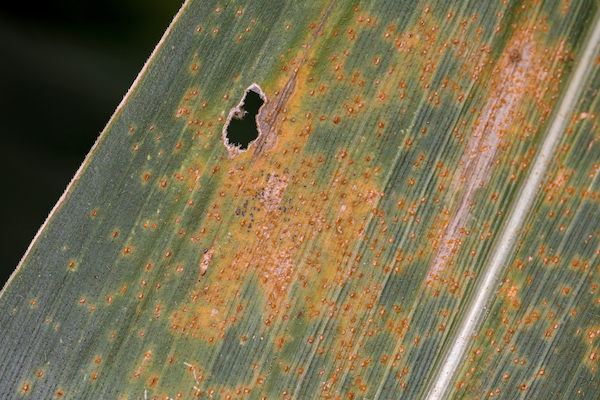Southern rust of corn is making an unusually aggressive advance across the Midwest this season.
Specialists report the fungus, which thrives in hot, humid weather, reached Iowa ahead of schedule — during early kernel development — and now appears to be affecting fields across the state. The speed of its spread has sparked concerns that yields could drop by as much as 30% in heavily infected areas.
The disease has already been confirmed in at least 18 states, including major corn producers like Illinois, Kansas, Minnesota, Missouri, Nebraska, and possibly Michigan.
Extended periods of rainfall and high humidity in parts of the western Corn Belt have created ideal conditions for the outbreak, and symptoms are visible in many fields.
How Southern Rust Damages Corn
Caused by the fungus Puccinia polysora, southern rust of corn forms clusters of tiny, raised pustules in shades of orange to light brown, usually concentrated on upper leaves but sometimes spreading to husks, stalks, or ear shanks. These structures break open to release spores that can travel long distances on the wind.
Once infection occurs, the affected leaves can no longer perform photosynthesis efficiently. This limits the plant’s ability to fill kernels with starch, often producing lighter grain and, in severe infections, prompting plants to mature too quickly or die prematurely.
Warm, wet conditions can accelerate the disease cycle, enabling new spores to form and disperse in just over a week.
Management and Treatment Timing
Fungicide use can help control southern rust of corn, but applying treatments during the window from tasseling to the milk stage (R3) tends to provide the best return on investment.
Spraying later in the season is generally less effective, and once the crop reaches the dent stage (R5), the likelihood of economic benefit is minimal. Because its appearance can resemble common rust, field scouting or lab testing is recommended before applying fungicides.
Tools like the Crop Protection Network’s interactive map allow producers to track confirmed cases in real time and prioritize which fields to check first.
Stay Vigilant to Safeguard Your Harvest
With the disease already widespread and able to travel long distances on air currents, regular monitoring and well-timed interventions can help reduce losses. Staying ahead of southern rust of corn can make the difference between a small setback and a major yield hit.
For support and product recommendations to help protect your crop, contact your local John Deere dealer today.
